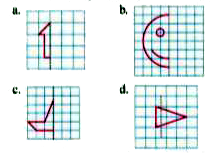Give an example of a figure that has a line of symmetry but does not have rotational symmetry.
To solve the question, we need to find a figure that has a line of symmetry but does not possess rotational symmetry. Let's break this down step by step.
1. Understanding Line of Symmetry:
A line of symmetry is a line that divides a figure into two identical halves that are mirror images of each other.
Hint: Think of a figure that can be folded along a line to create two equal parts.
2. Understanding Rotational Symmetry:
A figure has rotational symmetry if it can be rotated (less than a full turn) around a central point and still look the same as it did before the rotation.
Hint: Consider if rotating the figure at certain angles results in the same appearance.
3. Choosing a Figure:
An isosceles triangle is a good candidate. It has two equal sides and one line of symmetry that runs from the vertex opposite the base to the midpoint of the base.
Hint: Visualize an isosceles triangle and identify its symmetry line.
4. Checking for Line of Symmetry:
In an isosceles triangle, if you draw a vertical line from the apex (top vertex) down to the base, you will see that the two halves are mirror images of each other. Thus, it has one line of symmetry.
Hint: Draw the triangle and the line of symmetry to confirm the halves are identical.
5. Checking for Rotational Symmetry:
If you rotate the isosceles triangle at its center, it does not look the same at any angle other than 360 degrees. Therefore, it does not have rotational symmetry.
Hint: Try rotating the triangle at different angles and observe if it matches its original shape.
Conclusion:
The isosceles triangle is an example of a figure that has one line of symmetry but does not have rotational symmetry.
Summary:
- Figure: Isosceles Triangle
- Line of Symmetry: Yes (vertical line from apex to base)
- Rotational Symmetry: No
A line of symmetry is a line that divides a figure into two identical halves that are mirror images of each other.
A figure has rotational symmetry if it can be rotated (less than a full turn) around a central point and still look the same as it did before the rotation.
An isosceles triangle is a good candidate. It has two equal sides and one line of symmetry that runs from the vertex opposite the base to the midpoint of the base.
In an isosceles triangle, if you draw a vertical line from the apex (top vertex) down to the base, you will see that the two halves are mirror images of each other. Thus, it has one line of symmetry.
If you rotate the isosceles triangle at its center, it does not look the same at any angle other than 360 degrees. Therefore, it does not have rotational symmetry.
The isosceles triangle is an example of a figure that has one line of symmetry but does not have rotational symmetry.
- Figure: Isosceles Triangle
- Line of Symmetry: Yes (vertical line from apex to base)
- Rotational Symmetry: No
Topper's Solved these Questions
Similar Questions
Give an example of a geometrical figure which has neither a line of symmetry nor a rotational symmetry.
View SolutionName any two figures that have both line symmetry and rotational symmetry.
View SolutionName any two figures that have both line symmetry and rotational symmetry.
View SolutionWhat is the line of symmetry of a semi-circle? Does it have rotational symmetry?
View SolutionComplete the figures along the line of symmetry:

View SolutionFill in the blanks: English alphabet Letter, Line Symmetry, Number of Lines of symmetry, Rotational Symmetry, Order of rotational Symmetry Z S H O E N C, Nil - Yes Yes Yes - -, 0 - - - - - -, Yes - Yes Yes - Yes -, 2 - - - - - -
View SolutionGive three examples of shapes with no line of symmetry.
View SolutionWhich has no rotation of symmetry ?
View SolutionWrite three capital letters of the English alphabet that have line symmetry but not rotational symmetry?
View SolutionIf a figure has two or more lines of symmetry, should it have rotational symmetry of order more than 1?
View Solution

